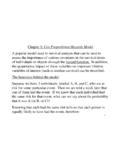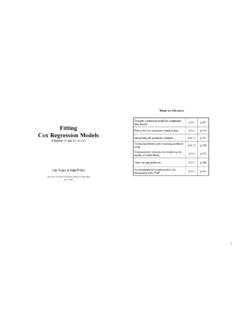Transcription of Enhancements to Proc PHReg for Survival Analysis in SAS 9
1 Enhancements to Proc PHReg for Survival Analysis in SAS Brenda Gillespie, University of Michigan Presented at the 2010 Michigan SAS Users' Group Schoolcraft College, Livonia, MI. April 27, 2010. 2006 Center for Statistical Consultation and Research, University of Michigan All rights reserved. Outline Overview and introduction to the cox model New features of the model statement The CLASS statement ( Yeah!!!!). The CLASS statement with time*covariate interactions The HazardRatio (HR) statement The ASSESS statement The Bayes statement The Covsandwich option (not new, but still great). Survival Analysis Methods to analyze time to event data. Useful for many different applications Time to death from disease diagnosis Length of hospital stay Time origin Event Time origin Censored value Cox Regression model h(t; x) = ho(t )exp{ 1x1+L+ kxk}.
2 Where h(t ; x) is the hazard function at time t for a subject with covariate values x1, xk, h0(t) is the baseline hazard function, , the hazard function when all covariates equal zero. exp is the exponential function (exp(x)= ex), xi is the ith covariate in the model , and i is the regression coefficient for the ith covariate, xi. Cox Regression (cont'd). h(t ; x ) = ho(t ) exp{ 1x1+L+ kxk}. The cox model is different from ordinary regression in that the covariates are used to predict the hazard function, and not Y itself. The baseline hazard function can take any form, but it cannot be negative. The exponential function of the covariates is used to insure that the hazard is positive. There is no intercept in the cox model .
3 (Any intercept could be absorbed into the baseline hazard.). Cox Regression (cont'd). h(t, xi). t The basic cox model assumes that the hazard functions for two different levels of a covariate are proportional for all values of t. For example, if men have twice the risk of heart attack compared to women at age 50, they also have twice the risk of heart attack at age 60, or any other age. The underlying risk of heart attack as a function of age can have any form. proportional Hazards To see the proportional hazards property analytically, take the ratio of h(t;x) for two different covariate values: h (t ; x i ) h 0 (t ) exp{ 1 x i1 + L + kx ik }. =. h ( t ; x j ) h 0 ( t ) exp{ 1 x j1 + L + kx jk }.
4 = exp{ 1( x i1 x j1) + L + k ( x ik x jk )}. ho(t) cancels out => the ratio of those hazards is the same at all time points. For a single dichotomous covariate, say with values 0 and 1, the hazard ratio is h (t ; x = 1) h 0 ( t ) e *1 e . = *0. = = e h (t; x = 0 ) h 0(t )e e 0. Partial Likelihood The partial likelihood function for one covariate is: . xi h (ti ) h 0 ( t i ) exp{ x i} e . PL = = = . i events h (tj ) i events h 0 ( t i ) exp{ x j} i events . j R i e xj . j R i j R i . where ti is the ith death time, xi is the associated covariate, and Ri is the risk set at time ti , , the set of subjects is still alive and uncensored just prior to time ti. The numerator is the hazard of death for the subject who died at time ti.
5 The denominator is the sum of hazards of death for all subjects in the risk set at time ti. The ratio reflects the likelihood that the death occurred to subject i. For the data below, with gender as the only covariate, the PL function is: sex=1. sex=1. sex=1. sex=0. sex=0. t=0 t1 t2 t3. 1 1 0 . e e e PL( ) = 1 1 0 0 . 1 0 0 . 0 . e +e +e +e e +e +e e Note: The first censored observation does not enter the PL. If =0, PL=1/4 x 1/3 x 1. See graph of PL( ) on next slide Graph of the Likelihood Function Many likelihood functions are approximately quadratic, concave functions (below, left). estimate is at the max In prev slide, PL increases indefinitely (below, right). is maximized at + (occurs with separation ).
6 Note early events for sex=1, later events for sex=0. PL(b) with separation Common PL( ) shape b PL(b). PL(b). b Partial Likelihood (cont'd). The beauty of the partial likelihood function is that for each event (death) there is one term, which only depends on the risk set at that point. PL = L1x L2 x ..x Ld , where d = # of deaths. = censored = death t=0 t1 t2 t3. This structure makes it easy to accommodate right censoring: A subject is in all risk sets up to the time of censoring, but not in any risk set after that point. incorporate time-varying covariates: A subject may be in many risk sets, but can have different covariate values in each. incorporate left-truncated data: A subject may not be in the first risk set(s), but may join later risk set(s) at any time.
7 Histstat/ Syntax for Cox Regression using PHReg . The time variable is days . The censor code is status (1=dead, 0=alive). Underlined items are user-specified proc PHReg ;. model days*status (0) = sex age;. output out=temp resmart=Mresids resdev=Dresids ressch=Sresids;. id subj group;. run;. Options of the model Statement Risklimits (RL). to get confidence intervals for hazard ratios NoDummyPrint (NODP). To suppress Class Level Information table Firth Better estimation when you have complete separation for one variable Selection=score Best=5. An alternative to stepwise regression, where all covariate subsets are considered and several options are presented Categorical Covariates Categorical covariates can be declared in a CLASS statement in SAS (finally!)
8 !). , 3 levels of edema (None, Mild, and Severe). By default, SAS uses Severe [=highest value]. as the reference category Dummy Variable Coding Effect Reference Design Matrix Design Matrix A A1 A2 A5 A A1 A2 A5. 1 1 0 0 1 1 0 0. 2 0 1 0 2 0 1 0. 5 0 0 1 5 0 0 1. 7 1 1 1 7 0 0 0. Estimates the difference Estimate the difference in in the effect of each level the effect of each level compared to the average compared to the reference effect over all four levels level. Time*Covariate Interactions with the Covariate in the CLASS statement To test of proportional hazard assumption for the design variables of A, use the following statements, proc PHReg data=Foo;. class A;. model T * Status(0) = A X1 X2.
9 X1= T*(A=1);. X2= T*(A=2);. run;. The PHReg Procedure Parameter Standard Hazard Parameter DF Pr > ChiSq Estimate Error Ratio A 1 1 A 2 1 X1 1 X2 1 Example: Time from Prison Release to Next Arrest n=432 male inmates released from Maryland state prisons in the 1970s The men were followed for one year. The dates of arrest were recorded. Out of several covariates (see Allison, p. 42- 43), we will focus on two: FIN = 1 if financial aid was received after release; FIN=0 if not (randomly assigned). AGE = age in years at the time of release The PHReg Procedure Data Set: RECID. Dependent Variable: WEEK. Censoring variable: ARREST. Censoring value(s): 0. Ties Handling: BRESLOW. Summary of the Number of Event and Censored Values Percent Total Event Censored Censored 432 114 318 Testing Global Null Hypothesis: BETA=O.
10 Without With Criterion Covariates Covariates model Chi-Square -2 LOG L with 7 DF (p= ). Score with 7 DF (p= ). Wald with 7 DF (p= ). Analysis of Maximum Likelihood Estimates Parameter Standard Wald Pr > Risk Variable DF Estimate Error Chi-Square Chi-Square Ratio FIN 1 AGE 1 RACE 1 WEXP 1 MAR 1 PARO 1 PRIO 1 Interpreting Covariate Effects Covariate effects are interpreted in terms of hazard ratios (HR), sometimes called risk ratios. HR=1 => no effect. ( , = 0). HR>1 => increasing hazard with increasing x. HR<1 => decreasing hazard with increasing x. For dichotomous variables, HR = exp( ). For FIN, HR = exp( ) = Those receiving financial aid have only 68%. the risk of arrest compared with those not receiving aid.












